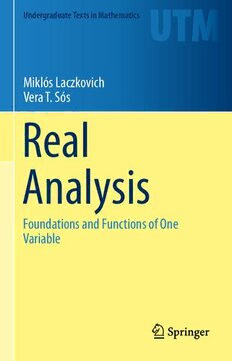Table Of ContentUndergraduate Texts in Mathematics
Miklós Laczkovich
Vera T. Sós
Real
Analysis
Foundations and Functions of One
Variable
Undergraduate Texts in Mathematics
Undergraduate Texts in Mathematics
SeriesEditors
SheldonAxler
SanFranciscoStateUniversity,SanFrancisco,CA,USA
KennethRibet
UniversityofCalifornia,Berkeley,CA,USA
AdvisoryBoard:
ColinAdams,WilliamsCollege
DavidA.Cox,AmherstCollege
PamelaGorkin,BucknellUniversity
RogerE.Howe,YaleUniversity
MichaelOrrison,HarveyMuddCollege
LisetteG.dePillis,HarveyMuddCollege
JillPipher,BrownUniversity
FadilSantosa,UniversityofMinnesota
Undergraduate Texts in Mathematics are generally aimed at third- and fourth-
year undergraduate mathematics students at North American universities. These
texts strive to provide students and teachers with new perspectives and novel
approaches. The books include motivation that guides the reader to an apprecia-
tionofinterrelationsamongdifferentaspectsofthesubject.Theyfeatureexamples
thatillustratekeyconceptsaswellasexercisesthatstrengthenunderstanding.
Moreinformationaboutthisseriesathttp://www.springer.com/series/666
Miklo´s Laczkovich • Vera T. So´s
Real Analysis
Foundations and Functions of One Variable
First English Edition
123
Miklo´sLaczkovich VeraT.So´s
DepartmentofAnalysis Alfre´dRe´nyiInstituteofMathematics
Eo¨tvo¨sLora´ndUniversity HungarianAcademyofSciences
Budapest,Hungary Budapest,Hungary
ISSN0172-6056 ISSN2197-5604 (electronic)
UndergraduateTextsinMathematics
ISBN978-1-4939-2765-4 ISBN978-1-4939-2766-1 (eBook)
DOI10.1007/978-1-4939-2766-1
LibraryofCongressControlNumber:2015938228
SpringerNewYorkHeidelbergDordrechtLondon
1stHungarianedition:T.So´s,Vera,Anal´ızisI/1©NemzetiTanko¨nyvkiado´,Budapest,1972
2ndHungarianedition:T.So´s,Vera,Anal´ızisA/2©NemzetiTanko¨nyvkiado´,Budapest,1976
3rdHungarianedition:Laczkovich,Miklo´s&T.So´s,Vera:Anal´ızisI©NemzetiTanko¨nyvkiado´,
Budapest,2005
4thHungarianedition:Laczkovich,Miklo´s&T.So´s,Vera:Anal´ızisI©Typotex,Budapest,2012
TranslationfromtheHungarianlanguage3rdedition:Valo´sanal´ızisIbyMiklo´sLaczkovich
&T.So´s,Vera,©NemzetiTanko¨nyvkiado´,Budapest,2005.Allrightsreserved©Springer2015.
©SpringerNewYork2015
Thisworkissubjecttocopyright.AllrightsarereservedbythePublisher,whetherthewholeorpartof
thematerialisconcerned,specificallytherightsoftranslation,reprinting,reuseofillustrations,recitation,
broadcasting,reproductiononmicrofilmsorinanyotherphysicalway,andtransmissionorinformation
storageandretrieval,electronicadaptation,computersoftware,orbysimilarordissimilarmethodology
nowknownorhereafterdeveloped.
Theuseofgeneraldescriptivenames,registerednames,trademarks,servicemarks,etc.inthispublication
doesnotimply,evenintheabsenceofaspecificstatement,thatsuchnamesareexemptfromtherelevant
protectivelawsandregulationsandthereforefreeforgeneraluse.
Thepublisher,theauthorsandtheeditorsaresafetoassumethattheadviceandinformationinthisbook
arebelievedtobetrueandaccurateatthedateofpublication.Neitherthepublishernortheauthorsor
theeditorsgiveawarranty,expressorimplied,withrespecttothematerialcontainedhereinorforany
errorsoromissionsthatmayhavebeenmade.
Printedonacid-freepaper
SpringerScience+BusinessMediaLLCNewYorkispartofSpringerScience+BusinessMedia(www.
springer.com)
Preface
Analysisformsanessentialbasisofmathematicsasawhole,aswellasofthenatural
sciences,andmoreandmoreofthesocialsciencestoo.Thetheoryofanalysis(dif-
ferentiationandintegration)wascreated—afterGalileo’sinsight—forthepurposes
ofdescribingtheuniverseinthelanguageofmathematics.Workingouttheprecise
theorytookalmost300years,withalargeportionofthistimedevotedtodefinitions
thatencapsulatetheessenceoflimitsandcontinuity.Masteringtheseconceptscan
beadifficultprocess;thisisoneofthereasonswhyanalysisisonlybarelypresent
inmosthigh-schoolcurricula.
At the same time, in postsecondary education where mathematics is part of the
program—including various branches of science and mathematics—analysis ap-
pears as a basic requirement. Our book is intended to be an introductory analysis
textbook;webelieveitwouldbeusefulinanyareaswhereanalysisisapartofthe
curriculum,inadditiontotheabove,alsointeachereducation,engineering,oreven
somehighschools.Inwritingthisbook,weusedtheexperiencewegainedfromour
manydecadesoflecturesattheEotvosLorandUniversity,Budapest,Hungary.
Wehaveplacedstrongemphasisondiscussingthefoundationsofanalysis:before
webegintheactualtopicofanalysis,wesummarizeallthatthetheorybuildsupon
(basicsoflogic,sets,realnumbers),eventhoughsomeoftheseconceptsmightbe
familiarfrompreviousstudies.Webelievethatastrongbasisisneedednotonlyfor
thosewhowishtomasterhigherlevelsofanalysis,butforeveryonewhowantsto
applyit,andespeciallyforthosewhowishtoteachanalysisatanylevel.
The central concepts of analysis are limits, continuity, the derivative, and the
integral.Ourprimarygoalwastodevelop thepreciseconceptsgradually,building
onintuitionandusingmanyexamples.Weintroduceanddiscussapplicationsofour
topicsasmuchaspossible,whileensuringthatunderstandingandmasteringofthis
difficultmaterialisadvanced.This,amongotherreasons,iswhyweavoidedamore
abstractorgeneral(topologicalormultiplevariable)discussion.
Wewouldliketoemphasizethatthe—classical,mostlymorethan100yearold—
resultsdiscussedherestillinspireactiveresearchindifferentareas.Duetothenature
ofthisbook,wecannotdelveintothis;weonlymentionasmallhandfulofunsolved
problems.
v
vi Preface
Masteringthematerialcanbeonlyachievedthroughsolvingmanyexercisesof
variousdifficulties.Wehaveposedmorethan500exercisesinourbook,butfewof
theseareroutinequestions—whichcanbefoundinmanyworkbooksandexercise
collections.However,wefounditimportanttoincludequestionsthatcallfordeeper
understandingofresultsandmethods.Ofthese,severalmoredifficultquestions,re-
quiringnovelideas,aremarkedby(∗).Alargenumberofexercisescomewithhints
for solutions, while many others are provided with complete solutions. Exercises
withhintsandsolutionsaredenotedby(H)and(S)respectively.
Thebookcontainsamuchgreateramountofmaterialthanwhatisnecessaryfor
most curricula. We trust that the organization of the book—namely the structure
ofsubsections—makestheselectionofself-containedcurriculapossibleforseveral
levels.
The book drew from Vera T. So´s’ university textbook Anal´ızis, which has been
inprintforover30years,aswellasanalysislecturenotesbyMiklo´sLaczkovich.
This book, which is the translation of the third edition of the Hungarian original,
naturally expands on these sources and the previous editions in both content and
presentation.
Budapest,Hungary Miklo´sLaczkovich
May16,2014 VeraT.So´s
Contents
1 ABriefHistoricalIntroduction .................................. 1
2 BasicConcepts................................................. 11
2.1 AFewWordsAboutMathematicsinGeneral ................... 11
2.2 BasicConceptsinLogic..................................... 11
2.3 ProofTechniques........................................... 15
2.4 Sets,Functions,Sequences................................... 21
3 RealNumbers ................................................. 27
3.1 DecimalExpansions:TheRealLine........................... 36
3.2 BoundedSets.............................................. 40
3.3 Exponentiation............................................. 45
3.4 FirstAppendix:ConsequencesoftheFieldAxioms .............. 48
3.5 SecondAppendix:ConsequencesoftheOrderAxioms ........... 49
4 InfiniteSequencesI ............................................ 51
4.1 ConvergentandDivergentSequences.......................... 53
4.2 SequencesThatTendtoInfinity .............................. 56
4.3 UniquenessofLimit ........................................ 58
4.4 LimitsofSomeSpecificSequences............................ 61
5 InfiniteSequencesII............................................ 63
5.1 BasicPropertiesofLimits ................................... 63
5.2 LimitsandInequalities ...................................... 65
5.3 LimitsandOperations....................................... 67
5.4 Applications............................................... 72
6 InfiniteSequencesIII........................................... 77
6.1 MonotoneSequences ....................................... 77
6.2 TheBolzano–WeierstrassTheoremandCauchy’sCriterion........ 82
vii
viii Contents
7 RudimentsofInfiniteSeries ..................................... 89
8 CountableSets................................................. 97
9 Real-ValuedFunctionsofOneRealVariable ......................103
9.1 FunctionsandGraphs .......................................103
9.2 GlobalPropertiesofRealFunctions ...........................108
9.3 Appendix:BasicsofCoordinateGeometry .....................115
10 ContinuityandLimitsofFunctions ..............................117
10.1 LimitsofFunctions.........................................121
10.2 TheTransferencePrinciple...................................131
10.3 LimitsandOperations.......................................136
10.4 ContinuousFunctionsinClosedandBoundedIntervals...........144
10.5 UniformContinuity.........................................150
10.6 MonotonicityandContinuity.................................153
10.7 ConvexityandContinuity....................................157
10.8 ArcLengthsofGraphsofFunctions...........................161
10.9 Appendix:ProofofTheorem10.81............................166
11 VariousImportantClassesofFunctions(ElementaryFunctions) ....167
11.1 PolynomialsandRationalFunctions...........................167
11.2 ExponentialandPowerFunctions .............................170
11.3 LogarithmicFunctions ......................................180
11.4 TrigonometricFunctions ....................................184
11.5 TheInverseTrigonometricFunctions ..........................193
11.6 HyperbolicFunctionsandTheirInverses .......................195
11.7 FirstAppendix:ProofoftheAdditionFormulas .................199
11.8 SecondAppendix:AFewWordsonComplexNumbers ..........201
12 Differentiation.................................................203
12.1 TheDefinitionofDifferentiability.............................203
12.2 DifferentiationRulesandDerivativesoftheElementary
Functions .................................................211
12.3 Higher-OrderDerivatives ....................................224
12.4 LinkingtheDerivativeandLocalProperties ....................229
12.5 IntermediateValueTheorems ................................237
12.6 InvestigationofDifferentiableFunctions .......................241
13 ApplicationsofDifferentiation...................................255
13.1 L’Hoˆpital’sRule ...........................................255
13.2 PolynomialApproximation ..................................258
13.3 TheIndefiniteIntegral ......................................270
13.4 DifferentialEquations.......................................276
13.5 TheCatenary ..............................................284
13.6 PropertiesofDerivativeFunctions ............................286
Contents ix
13.7 FirstAppendix:ProofofTheorem13.20 .......................289
13.8 SecondAppendix:OntheDefinitionofTrigonometricFunctions
Again ....................................................291
14 TheDefiniteIntegral ...........................................295
14.1 ProblemsLeadingtotheDefinitionoftheDefiniteIntegral........295
14.2 TheDefinitionoftheDefiniteIntegral .........................299
14.3 NecessaryandSufficientConditionsforIntegrability.............305
14.4 IntegrabilityofContinuousFunctionsandMonotoneFunctions....315
14.5 IntegrabilityandOperations..................................317
14.6 FurtherTheoremsRegardingtheIntegrabilityofFunctionsand
theValueoftheIntegral .....................................320
14.7 InequalitiesforValuesofIntegrals ............................325
15 Integration ....................................................333
15.1 TheLinkBetweenIntegrationandDifferentiation ...............333
15.2 IntegrationbyParts.........................................340
15.3 IntegrationbySubstitution...................................346
15.4 IntegralsofElementaryFunctions.............................350
15.4.1 RationalFunctions ...................................350
15.4.2 IntegralsContainingRoots ............................354
15.4.3 RationalFunctionsofex ..............................355
15.4.4 TrigonometricFunctions ..............................355
15.5 NonelementaryIntegralsofElementaryFunctions ...............358
15.6 Appendix:IntegrationbySubstitutionforDefiniteIntegrals(Proof
ofTheorem15.22)..........................................363
16 ApplicationsofIntegration......................................367
16.1 TheGeneralConceptofAreaandVolume......................369
16.2 ComputingArea ...........................................371
16.3 ComputingVolume.........................................376
16.4 ComputingArcLength......................................380
16.5 PolarCoordinates ..........................................388
16.6 TheSurfaceAreaofaSurfaceofRevolution....................392
16.7 Appendix:ProofofTheorem16.20............................396
17 FunctionsofBoundedVariation .................................399
18 TheStieltjesIntegral ...........................................407
19 TheImproperIntegral..........................................417
19.1 TheDefinitionandComputationofImproperIntegrals ...........417
19.2 TheConvergenceofImproperIntegrals ........................428
19.3 Appendix:ProofofTheorem19.13............................435

